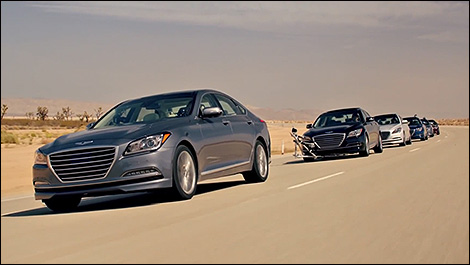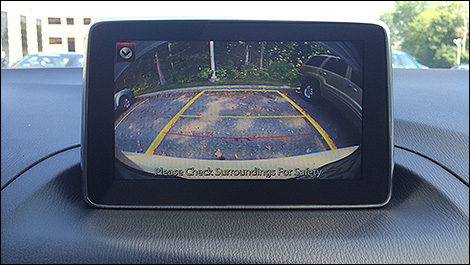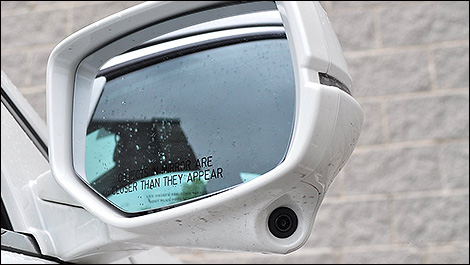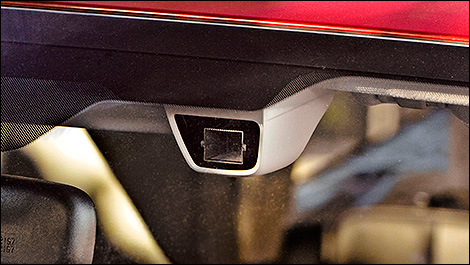Sep
8th
Stay connected Subscribe to our RSS feed
Have you seen this commercial? In it, stunt drivers in a rolling train of Hyundai's latest Genesis Sedans exit the moving vehicles in a totally “do not try this at home” fashion, letting the safety systems bring the driverless train of cars to a stop when the lead vehicle applies some heavy braking.* The gist? Using radar, lasers, and (more than ever) cameras today's breed of high-tech rides is becoming more self-aware and safe than ever.
Today, cameras are cheaper, better and smaller than ever before, and they're winding up more and more often in new rides, powering advanced safety and hazard-detection systems like those showcased in the commercial.
Many new camera-based features exist, so here's a look at how automakers are tapping into advanced camera technology to make rides that are easier than ever to drive safely.
A do-it-all Backup Camera: On some Nissan models, the backup camera system has numerous added responsibilities. In addition to displaying a real-time image of the area behind the reversing vehicle, the wide-angle camera watches the area at the rear of your vehicle for signs of trouble.
Since the rearview cam can see the road markings, it powers the Lane Departure Warning System, which alerts drivers if they're accidentally venturing out of their lane. The camera can also see the vehicle's blind-spots, and powers the Blind Spot Warning System to tell drivers if they're about to side-swipe a Corolla when changing lanes. Nissan's even developed a cleaning system that pipes a single drop of washer fluid onto the camera lens and blasts it clean with a whiff of compressed air, so there's always a good view.
The new Mercedes S-Class can even see out of its backup camera to determine if it's about to be rear-ended by another vehicle. If it is, the brakes are pre-locked, helping minimize subsequent collisions.
LaneWatch Camera: Signal right, and the camera mounted to the passenger side mirror of numerous Honda models displays a wide-angle video down the side of the car on the central display screen for added safety. The camera can be activated by pressing a button on the end of the turn-signal lever, too.
My father is an avid cyclist who frequently complains of being cut off by cars turning right, and this system could enhance safety for dad and his pals. From the driver's seat, added confidence results from the ability to triple-check your blind-spot via the wide-angle camera. In all, drivers get a better sense of what's going on near their ride.
360 Degrees of Awareness: Imagine being able to see 360 degrees around your vehicle on a single screen when you back up. That's what numerous automakers, including BMW, Volvo, Land Rover, Nissan, and Mercedes-Benz are doing with their advanced parking camera systems. Using inputs from multiple cameras, an image processor simulates a virtual birds-eye view of the area around your ride in real time. Drivers get added confidence in tight quarters, since they're able to see completely around their ride on a single screen.
Land Rover has even expanded on this type of system with camera angles that display the wheels and path of travel ahead -- presumably for precise and puncture-free tire placement in an off-road setting.
Smart Rearview: Using a high-resolution camera mounted at the rear of the vehicle and an LCD monitor in the rearview mirror, Nissan's Smart Rearview system puts a forward-thinking take on seeing behind you. The Smart Rearview system works just like a normal rearview mirror -- although it's not obstructed by rear seats, passengers, interior panels or tall items you might be carrying in the cargo hold. Drivers get a better, wider, and non-obstructed view out the back of their ride, and thanks to advanced image processing software they can see more clearly in rain, snow, in the dark, and in situations where glare might be an issue. You can turn the system off and use the good old-fashioned rearview mirror, if you like.
EyeSight: Subaru is big on safety, and their latest EyeSight system takes it to new levels. Using a pair of cameras mounted side by side (just like human eyes) to see in 3D (just like human eyes) the system powers features like Adaptive Cruise Control, Lane Departure Warning and Pre-Collision Braking for added confidence. EyeSight can even see clumsy pedestrians text-walking in front of your Outback and apply the brakes to avoid hitting them, in some situations. Hell, if there's a stationary car in front of you, EyeSight can even tell the throttle to ignore your foot for a moment, so you don't accidentally rear-end someone if you suffer a momentary case of pedal confusion.
Night Vision: It's been the curse of mankind's existence for millenniums: pesky lions, raccoons and fruit-bats can see in the dark, while we humans fumble around and whack into stuff like Jim Lahey on a Sunday afternoon bender.
Automakers have responded to our nocturnal vision handicaps and created a solution: Night Vision. Once reserved solely for military use, night-vision technology is available in numerous premium rides, allowing you to “see” differences in temperature between various surfaces or to see reflections from infrared light that's blasted ahead of the ride.
An enhanced view of the area ahead is displayed for the driver -- potentially providing early warning of hazards up the road. Some systems even highlight pedestrians or animals on-screen before they're visible to drivers in their headlights.
*Note that the systems were modified for the filming of the commercial. In real-world application the camera-guided cruise would shut off once the car detected a lack of presence on the steering wheel. In other words, do not try this it at home with your new Hyundai Genesis Sedan.
Today, cameras are cheaper, better and smaller than ever before, and they're winding up more and more often in new rides, powering advanced safety and hazard-detection systems like those showcased in the commercial.
Many new camera-based features exist, so here's a look at how automakers are tapping into advanced camera technology to make rides that are easier than ever to drive safely.
 |
A do-it-all Backup Camera: On some Nissan models, the backup camera system has numerous added responsibilities. In addition to displaying a real-time image of the area behind the reversing vehicle, the wide-angle camera watches the area at the rear of your vehicle for signs of trouble.
Since the rearview cam can see the road markings, it powers the Lane Departure Warning System, which alerts drivers if they're accidentally venturing out of their lane. The camera can also see the vehicle's blind-spots, and powers the Blind Spot Warning System to tell drivers if they're about to side-swipe a Corolla when changing lanes. Nissan's even developed a cleaning system that pipes a single drop of washer fluid onto the camera lens and blasts it clean with a whiff of compressed air, so there's always a good view.
The new Mercedes S-Class can even see out of its backup camera to determine if it's about to be rear-ended by another vehicle. If it is, the brakes are pre-locked, helping minimize subsequent collisions.
 |
| Photo: Olivier Delorme |
LaneWatch Camera: Signal right, and the camera mounted to the passenger side mirror of numerous Honda models displays a wide-angle video down the side of the car on the central display screen for added safety. The camera can be activated by pressing a button on the end of the turn-signal lever, too.
My father is an avid cyclist who frequently complains of being cut off by cars turning right, and this system could enhance safety for dad and his pals. From the driver's seat, added confidence results from the ability to triple-check your blind-spot via the wide-angle camera. In all, drivers get a better sense of what's going on near their ride.
 |
| Photo: Olivier Delorme |
360 Degrees of Awareness: Imagine being able to see 360 degrees around your vehicle on a single screen when you back up. That's what numerous automakers, including BMW, Volvo, Land Rover, Nissan, and Mercedes-Benz are doing with their advanced parking camera systems. Using inputs from multiple cameras, an image processor simulates a virtual birds-eye view of the area around your ride in real time. Drivers get added confidence in tight quarters, since they're able to see completely around their ride on a single screen.
Land Rover has even expanded on this type of system with camera angles that display the wheels and path of travel ahead -- presumably for precise and puncture-free tire placement in an off-road setting.
Smart Rearview: Using a high-resolution camera mounted at the rear of the vehicle and an LCD monitor in the rearview mirror, Nissan's Smart Rearview system puts a forward-thinking take on seeing behind you. The Smart Rearview system works just like a normal rearview mirror -- although it's not obstructed by rear seats, passengers, interior panels or tall items you might be carrying in the cargo hold. Drivers get a better, wider, and non-obstructed view out the back of their ride, and thanks to advanced image processing software they can see more clearly in rain, snow, in the dark, and in situations where glare might be an issue. You can turn the system off and use the good old-fashioned rearview mirror, if you like.
EyeSight: Subaru is big on safety, and their latest EyeSight system takes it to new levels. Using a pair of cameras mounted side by side (just like human eyes) to see in 3D (just like human eyes) the system powers features like Adaptive Cruise Control, Lane Departure Warning and Pre-Collision Braking for added confidence. EyeSight can even see clumsy pedestrians text-walking in front of your Outback and apply the brakes to avoid hitting them, in some situations. Hell, if there's a stationary car in front of you, EyeSight can even tell the throttle to ignore your foot for a moment, so you don't accidentally rear-end someone if you suffer a momentary case of pedal confusion.
 |
| Photo: Subaru |
Night Vision: It's been the curse of mankind's existence for millenniums: pesky lions, raccoons and fruit-bats can see in the dark, while we humans fumble around and whack into stuff like Jim Lahey on a Sunday afternoon bender.
Automakers have responded to our nocturnal vision handicaps and created a solution: Night Vision. Once reserved solely for military use, night-vision technology is available in numerous premium rides, allowing you to “see” differences in temperature between various surfaces or to see reflections from infrared light that's blasted ahead of the ride.
An enhanced view of the area ahead is displayed for the driver -- potentially providing early warning of hazards up the road. Some systems even highlight pedestrians or animals on-screen before they're visible to drivers in their headlights.
*Note that the systems were modified for the filming of the commercial. In real-world application the camera-guided cruise would shut off once the car detected a lack of presence on the steering wheel. In other words, do not try this it at home with your new Hyundai Genesis Sedan.
 |
| Photo: Audi |
 The latest auto news, reviews, prices, product and vehicle releases.
The latest auto news, reviews, prices, product and vehicle releases.